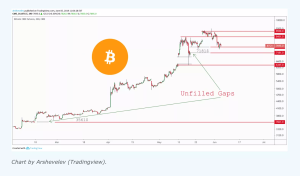Spotting The CME Gap: A Bitcoin Trader's Weekend Insight

Image Source: DepositPhotos
Imagine you are a Bitcoin trader and you finish your week on Friday afternoon. You know that while you can take a break, the Bitcoin market doesn't, it runs 24/7. However, the Chicago Mercantile Exchange (CME), where Bitcoin futures are traded, closes for the weekend. This creates one of the rarest scenarios known to traders who are familiar with the CME Gap.
What is the CME Gap?
The CME Gap is the price difference that often occurs between Friday's closing price and Sunday's opening price of Bitcoin futures on the CME. While cryptocurrency exchanges never stop trading, the CME has specific hours and closes over the weekend. During this outage, the Bitcoin spot market can experience price movements that are not reflected in CME futures until the market reopens.
Why the Chicago Mercantile Exchange?
Market Impact: The CME is one of the largest and most influential futures exchanges in the world. Bitcoin futures traded there attract significant volume and interest from both institutional and retail investors. Therefore, any gaps that arise are taken seriously by the market.
Regulated Environment: Operating under strict regulation, the CME provides a trusted platform for institutional investors. This regulation means that movements on the CME are recognized as important and reliable indicators of broader market trends.
Trading Strategies: Many traders believe that these gaps tend to “fill”, meaning that the price of Bitcoin will eventually return to the levels seen at the CME's close on Friday or open on Sunday. This belief influences their trading strategy as they wait for price corrections to close these gaps.
How to Spot a CME Gap
You can spot a CME gap on a Bitcoin futures chart in a few steps. Remember these tricks when analyzing charts:
(Click on image to enlarge)

- Choose the Right Time Frame: Gaps are most visible on shorter time frames, such as 1-hour or 4-hour charts, which give a detailed view of price movements over the weekend.
- Identify Weekend Periods: Focus on periods when the CME is closed. The CME closes at 16:00 Central Time (CT) on Friday and reopens at 17:00 on Sunday.
- Look for Price Gaps: On the chart, observe the price difference between the last trading price on Friday and the first trading price on Sunday. This difference is the CME gap. For example, if the closing price on Friday was $30,000 and the opening price on Sunday was $30,500, the difference of $500 is the CME gap.
- Visual Indicators: Some charting platforms offer gap detection indicators that automatically highlight these gaps for easier identification.
As a trader you notice this gap and remember that historically these gaps tend to be filled. You can anticipate that price will pull back at some point and take your position accordingly. This position may involve advanced strategies to utilise this gap placing a sell order near the top of the gap, or watching the price fall to buy at a lower level and bet on the gap being filled.
More By This Author:
Common Pitfalls In Short-Term Trading And How To Avoid Them
Exploring The 3 Prominent Crypto Trends Post Halving
The Long/Short Ratio In Crypto Trading
Disclaimer: The information provided on this article is for general informational purposes only. It does not constitute professional advice. Please consult with appropriate professionals ...
more


